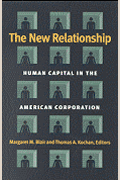Studies in this week’s Hutchins Roundup find loans granted forbearance are more likely to default, firms in big cities have more incentives to adopt skill-biased technologies, and more.
Want to receive the Hutchins Roundup as an email? Sign up here to get it in your inbox every Thursday.
Loans granted forbearance are more likely to default
When a financial crisis threatens to force borrowers into default, banks often pursue a wide variety of forbearance mechanisms. Katharina Bergant of the International Monetary Fund and Thore Kockerols of the Norges Bank use loan-level data on all Irish commercial banks and find that, in the long-run, borrowers granted forbearance in the previous six months were 20% more likely to default on the loan. Moreover, banks with a higher ratio of non-performing loans were more likely to grant forbearance. At a bank with average stress levels, the odds of a risky loan receiving forbearance was 28.5% higher than that of a safe loan. The authors find that banks that grant more forbearance are less likely to make new loans, and question the wisdom of forbearance in an economic crisis, given that it ties up resources that could have been used for new loans and doesn’t effectively reduce the probability of default.
Firms located in big cities have more incentives to adopt skill-biased technologies than firms in small cities
Since the 1980s, the wage premium for working in a bigger city has grown more for high-skilled workers than for low-skilled workers, and the ratio of high-skilled to low-skilled workers has grown more in large cities than in small ones. Larger cities have also seen smaller declines in “business dynamism,” that is, the rates of firm entry and exit and job creation. Hannah Rubinton of the Federal Reserve Bank of St. Louis argues that these disparities across cities are driven by differing adoption rates of skill-biased technologies that, in turn, reflect varying incentives to adopt new technology across cities. In particular, she finds that firms have greater incentives to invest in new skill-biased technologies in cities that are big, are more productive in using high-skilled workers, and have amenities attractive to high-skilled workers. These characteristics are more typical of large cities than small ones. As more firms in a city adopt new technologies, the smaller, less-productive firms are driven out, further amplifying the differences in rates of technological change across large and small cities. Using data from the government’s Annual Capital Expenditures Survey, she finds that firms in big cities spend more on information and communication technology (ICT) than firms in smaller ones. For example, a doubling of market size—as measured by the 1980 working-age population—is associated with a 3.99% increase in ICT spending today.
Age discrimination increases during recessions
Gordon B. Dahl from the University of California, San Diego, and Matthew M. Knepper from the University of Georgia find that age discrimination is more common during recessions because employers have more workers from which to choose. Specifically, they find that a one percentage point increase in a state’s unemployment rate leads to a 4.8% increase in complaints filed under the Age Discrimination in Employment Act related to age discrimination in firing, a 3.4% increase in charges related to hiring, and a 0.7% increase in the probability that a case is found meritorious by the Equal Employment Opportunity Commission (EEOC). In addition, in an experiment conducted during the recovery from the Great Recession in which fictitious resumes of women between 55 and 58 years old versus women between 35 and 42 years old were sent to prospective employers, the authors found each one percentage point increase in the unemployment rate lowered the older applicants’ likelihood of a callback by 18%. When resumes of both older and younger women were submitted for a position, the older women’s callback rate fell by an extraordinary 63%.
Chart of the week: Gold and Silver Prices in U.S. Dollars
Quote of the week:
“The target of economic policy has been to minimize the longer-term ‘scarring’ of our economy’s muscle; muscle that is made up of your and other businesses. The aim is to minimize the harm to our productive capacity – to allow output and employment to get as close as possible to their pre-COVID paths, once public health measures are lifted fully. Scarring could arise easily. To sustain employment and productive capacity through the virus disruption, wages, leases, interest, invoices and fixed costs need to continue to be paid even as revenues collapse. Many long-term viable businesses will face cash-flow shortfalls that, unless they can be bridged, will result in redundancies, business closures and scrapping of productive assets. Signs of that are already evident. In scale, such upheaval could tear the muscle of the economy in a way that would be difficult to put back together. The scars could damage the economy’s performance for a long time to come,” says Alex Brazier, Executive Director for Financial Stability Strategy and Risk and Member of the Financial Policy Committee at the Bank of England.
“While the financial system has been given every assistance to meet the needs of the wider economy and has made a good start, it needs to do even more if scarring of the economy is to be minimized. And more equity will be needed: to help some companies through the disruption; to build new economic muscle to grow to replace that which is lost, and to help others restructure once the disruption is over and avoid the burden of debt hanging over investment and employment.”
The Brookings Institution is committed to quality, independence, and impact.
We are supported by a diverse array of funders. In line with our values and policies, each Brookings publication represents the sole views of its author(s).












Commentary
Hutchins Roundup: Loan forbearance, skill biased technologies, and more
July 30, 2020